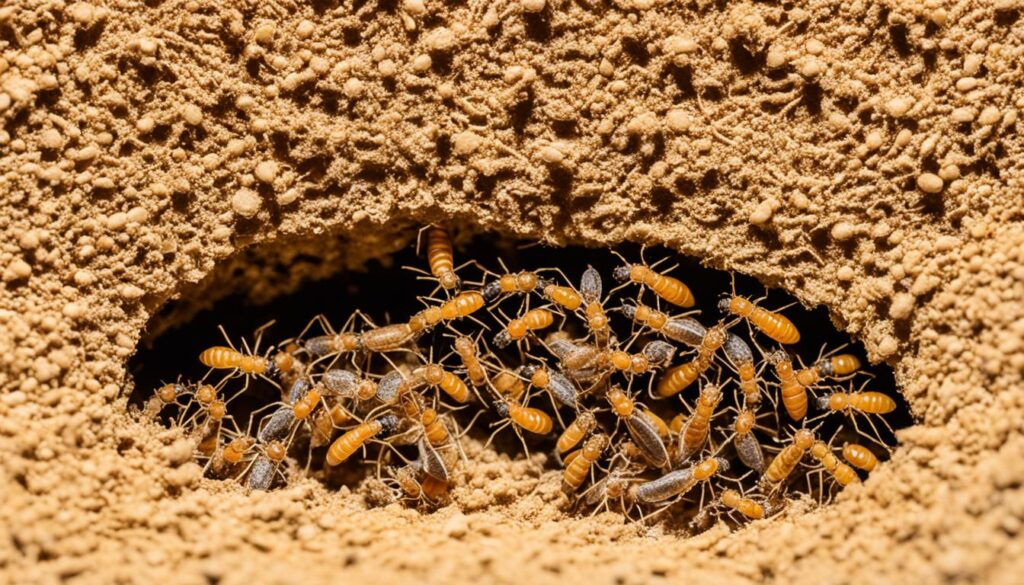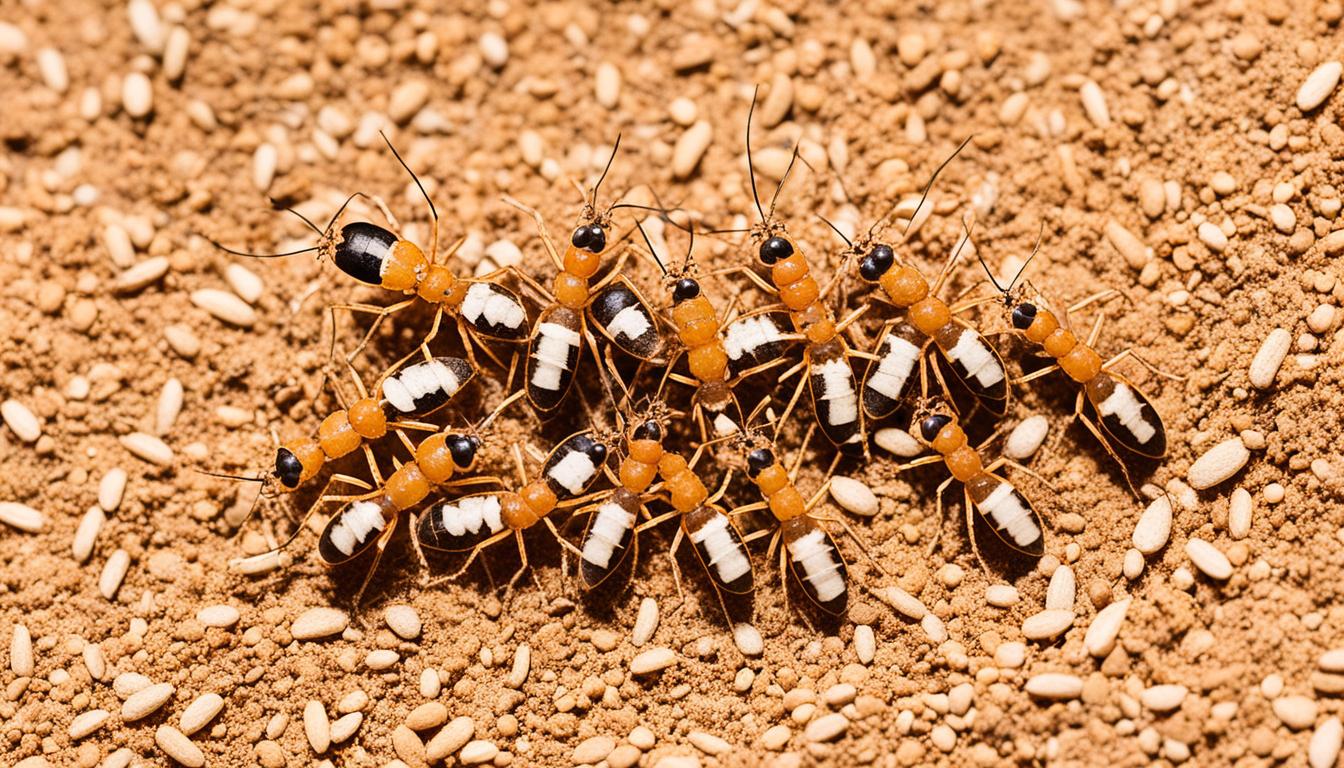Did you know there are about 2,000 termite species around the world? Arizona has subterranean and drywood termites, which pose a big risk to buildings. It’s vital to know Arizona’s termite species for the best prevention and control methods.
Arizona’s subterranean termites fall into three groups. The desert subterranean termites, like the common desert subterranean termite (Heterotermes aureus), prefer the hot south. Arid subterranean termites live in various places, from deserts to high elevations. Although not common, desert dampwood termites can still be a problem near woods.
On the flip side, Western drywood termites in Arizona don’t need soil and live in dry wood. They can do a lot of damage and are easily moved around. This makes them a big concern for buildings in Arizona.
Introduction to Desert Termites
In the dry American Southwest, you’ll find many kinds of termites. Each type has its own way of dealing with the desert. Subterranean termites are a group that lives well in Arizona, Nevada, and New Mexico. They can handle the hot weather and lack of plants.
Subterranean Termites in Arizona
Subterranean termites in this area include desert, arid, and dampwood types. Desert subterranean termites thrive in extreme heat. They leave a honeycomb pattern and build mud tubes to protect themselves as they look for food. This food is usually wood or other plant materials.
Arid subterranean termites are also found in many desert spots. They eat not only wood but other things too. They help the desert by breaking down dead plants and recycling those nutrients. Desert dampwood termites are not as common. But they can damage poles and fences by burrowing into them.
| Termite Species | Habitat | Feeding Preferences | Colony Structure |
|---|---|---|---|
| Desert Subterranean Termites | Arid, hot environments | Cellulose-rich materials, including wood, plant debris, and soil organic matter | Honeycomb patterns, mud tubes |
| Arid Subterranean Termites | Diverse desert environments | Wide range of cellulose-based materials, including wood, grass, and plant parts | Complex underground tunnels and nests |
| Desert Dampwood Termites | Poles, fenceposts with direct soil contact | Damp, decaying wood | Burrow into wood, less common |
These termites are important for the desert’s balance. They break down dead plants and enrich the soil. It’s key to know how they live to protect the desert.

Western Drywood Termites
Western drywood termites are different from other kinds. They don’t need to be underground. They can live in dry wood above ground. You can find them in roof materials or wood around homes. They aren’t as thirsty as some termites, but they like water from leaky pipes.
These termites live in the southwest part of the United States. They are from the coast of California to northern California. They are also in Oregon, Washington, and even in central Arizona. You might find them in places like the high desert where there are trees.
In late fall, the flying termites, or alates, come out. In southern California, this happens from September to November. Places like Palm Springs might see them as soon as May. They can’t fly far, usually only 6 to 10 feet. But some can go up to 100 or 250 feet away from where they started.
The termite queen starts slow, laying 2 to 5 eggs in her first year. But after that, she can lay 8 to 15 eggs a year. She keeps this up for 10 to 12 years. These termites aren’t just in the United States. They have been found in places like Canada and even in China and Japan.

Desert Termite Species Names
Amitermes
- Amitermes amifer
- Amitermes emersoni
- Amitermes foreli
- Amitermes hastatus
Anacanthotermes
- Anacanthotermes ahngerianus
- Anacanthotermes ochraceus
- Anacanthotermes vagans
Gnathamitermes
- Gnathamitermes perplexus
- Gnathamitermes tubiformans
Heterotermes
- Heterotermes aureus
- Heterotermes gabonensis
- Heterotermes platycephalus
- Heterotermes validus
Microhodotermes
- Microhodotermes viator
Psammotermes
- Psammotermes allocerus
- Psammotermes hybostoma
Tenuirostritermes
- Tenuirostritermes brenni
Trinervitermes
- Trinervitermes bettonianus
- Trinervitermes rhodesiensis
- Trinervitermes trinervoides
The Southwestern United States has many termite species. They live well in the dry desert lands. These desert termite species are specially adapted to harsh deserts like the Sonoran and Chihuahuan.
The desert termite, Gnathamitermes tubiformans, is common in the Southwest. It lives in places like western Texas, New Mexico, and Arizona. This termite helps the environment by breaking down dead plants in grasslands.
Another well-known species is the arid subterranean termite, Heterotermes aureus. It builds mud tubes and likes eating springwood. This gives a honeycomb look to the damaged wood. It is often found in the Sonoran Desert, where it eats dead blue palo verde trees.
The desert dampwood termite is found in the Southwest too. They like damp wood under the ground. This might be tree roots or doorframes. While they do not cause big economic harm, controlling them is hard. It often needs a pest expert.
The western drywood termite is a problem for buildings in the Southwest. It lives in dry, old wood, which is common in structures. This can be a concern for homes and companies.
Knowing about these desert termite species helps in keeping them from causing harm. It’s important for taking care of the environment and structures in the Southwestern United States.
Conclusion
Desert termites in the southwestern United States are a big deal. We have to know about the different types and what they do. This way, we can keep our homes and businesses safe from their harm.
If you live in places like Arizona, Nevada, or New Mexico, watch out for termites. Always work with experts to catch and stop them early. Being proactive helps keep our buildings strong and us safe.
The Southwest’s ecosystem is full of interesting creatures, including termites. They have a special place in the circle of life here. By using good ways to manage them, we can live alongside them. This helps us protect our favorite spaces.

